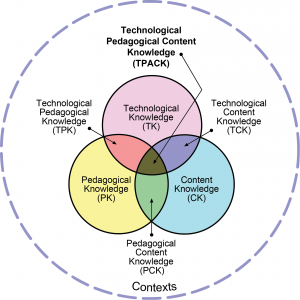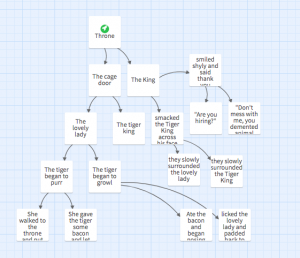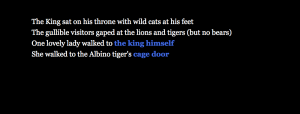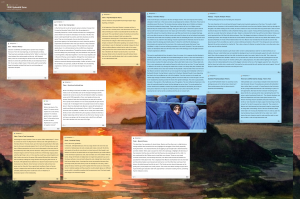Learning with technology
When I began University, access to computer technology was in its infancy. I used it for word processing primarily and with the growth of the internet, for research. As a student I was learning from technology, not with technology (Howland, Johnson & Marra, 2012), and I had no role models to show me otherwise. By 2020, the goals of education have changed to reflect the skills and attitudes needed in a knowledge based world and the integration of technology for meaningful learning. Many educators such as myself are trying to catch up with the present opportunities and use it to enrich our curriculum. I work in a 1:1 digital school teaching English Studies and I confess I thought I was utilizing this opportunity well with the use of Edublogs, interactive grammar websites and access to media sources. Although my pedagogy is fairly progressive, some writing activities are stuck in history and my new assessment style is just emerging. After exploring the readings and discussions in EDCP 570, I am ready to step into the future and utilize technology in a more meaningful and constructive manner. As Howland et al. conclude, “Technology cannot teach students. Rather, students learn as they use technology.” (2012, p. 16). For English Studies content, technology should engage students in:
- Knowledge construction, not reproduction
- Articulation, not repetition
- Reflection, not prescription
- Collaboration, not competition (Howland et al., p.16-17)
I am not advocating for a complete rebuild of my English Studies class to integrate technology in every lesson. Some of those old pen and paper lessons and the occasional worksheet still have a place in my pedagogy. And in my opinion, reading off a computer screen is not the same as holding a book in one’s hands. What I am exploring is a pivot of thinking about the use of technology in the English classroom; one in which I still use presentation and word processing programs like Microsoft Word and PowerPoint for writing and presenting but also integrate a more constructionist style of learning in which the student’s computers are used to create knowledge, not just record it. I also want to explore TPACK, “the union of those three [content knowledge, pedagogy, and technology]…is the knowledge of how technologies can best be employed in different pedagogies for facilitating the acquisition of content knowledge” (Howland et al., p. 15) in which the students use technology to enhance their understanding of the English Studies concepts.
Since the students are learning at home because of Covid-19, this presents a unique opportunity to discover new technology based pedagogy. My investigations are illustrated in two different units I am presently exploring: digital storytelling and online literature circles. I am still creating curriculum with the digital storytelling unit, but I am in the process of implementing the literature circle lessons and will share my early reflections and feedback on the process.
Digital Storytelling
Interactive Fiction
Story telling is one of the foundations of English Language classes around the world. Teachers know that among many things, stories entertain, share information, create emotional connections, help us remember, and gain a deeper understanding of other people’s experiences. The First People’s of Canada used oral storytelling to pass down wisdom, tradition, practical knowledge, and history. Too often students think that stories only come from between dusty book covers, or dead poets; many see the computer as just a modern typewriter. But technology can be used to help in the creation and presentation of stories. It is up to teachers to broaden this interpretation to include the countless other genres including interactive digital storytelling.
Full disclosure: I have not tried digital storytelling with the class yet. I am showing my own growth mindset and switching from my usual do-think-do pedagogy to think-do- think (Tishman, Jay & Perkins, 2001). I want to try teaching this activity in the Fall with my creative writing class, reflect on its effectiveness by looking at student reflections, then make adjustments. This is what I intend to try.
Two popular platforms for interactive digital storytelling are Twine and Inkelwriter. This article piqued my interest to look at Twine in more detail. The stories on Twine are like the old school “choose your own adventure” story that give power to the reader. Twine is also used for making digital games, which would be interesting for the gaming students to explore. I played with Twine and had fun recreating potential plot twists in the Netflix show The Tiger King.
I noticed that while I was creating my story, I was forced to think about the structure, the pacing, the imagery and a plot. Now that I have done a rough draft, I want to go back and make revisions to word choices and poetic devices to make it more entertaining. With students, I would ask them to map out a rough draft of the story first, but then let the creative process take them where they want to go. After this is completed, I would ask them to do some peer “testing” and get feedback. Time to revise would be offered then a “sharing stories day” would be scheduled. What I like about this project is it can enter a creative process at many points. For example, the students can do as I did and base the plot on a short story or novel we are studying, but play with the endings; of course, they can also create a whole new story. Here are two more examples of Twine stories that show the full capabilities of this site: Tundra and The Bogey Man.
Constructionist activities using technology can be collaborative and cooperative and structured many ways. As mentioned above, a teacher can set up opportunities for students to get feedback from their peers about their story, but a teacher can go beyond this simple practice. I propose the “yes, and” technique I have used in the past. Two or more students sit at a desk with a stack of stickie notes or with their computers in front of them with a shared screen. Personally, I would rather begin with stickie notes for the simple reasoning that they could stand up, move around and be off a screen for part of the process. Students first agree on a topic and title, then they proceed to add to the story one at a time. So student A says, “The dragon flew across the sky and breathed fire at the castle.” Student B says, “Yes, and… the princess in the castle pushed a button that lifted the secret shield bubble over the castle.” Taking turns, each writes their idea on a stickie note and adds it to a plot diagram. When they feel they have exhausted their story, they can shuffle/add/delete the stickie notes around until they come to a consensus. They can then write the story on Twine or Inklewriter and make changes as needed. Another way to encourage cooperation, on a grander scale, is to team students up from other classes to work together on a story. For example, I work at a school that has a media design class. If the timetable allows, combining the two classes to build on each other’s skills would provide a more “real world” collaborative process where the gaming expert can create a digital game from the English students short story. There are so many features on Twine beyond the basic storytelling that the students can explore together. Twine has many lesson plan ideas that are free to use.
Coding
The links between computer program coding, storytelling and English Studies seem fuzzy, but coding is one more way to bring meaningful, authentic learning into a grade 4-12 English classroom. As Mitch Resnick argues in “Let’s Teach Kids to Code”, coding teaches kids how to use technology in a meaningful, authentic fashion outside of texting, gaming and social media. They learn to be fluent writing with new technologies: “They are learning to code, but more importantly, they are coding to learn” (2:14) Just like reading and writing are the foundation for learning, coding is the foundation for learning in modern digital mediums.
Coding teaches meaningful learning skills such as experimentation, breaking complex ideas into simple parts, thinking creatively, and working systematically and collaboratively. Scratch is one platform that can be used to code a story. I created one called “The Covid-15” as seen in the link.

The Covid 15
I struggled figuring out the options and what each “block” meant. I had the basic story in my mind, but as I learned new options, I adapted and revised until I was satisfied with my product. I became frustrated on numerous occasions but when challenged, I became more determined to achieve my goal and started investigating other sites and asking friends to help with the process. Petrich, Wilkenson and Bevan (2013) have found that “It is the personal accomplishment of being unstuck, plus having the artifact to point to-… yet has resolved the problem that so puzzled the learner… their ideas, creativity, thinking, and resilience are validated in their own eyes” (p. 56) that can make one’s learning so meaningful. I am not assuming that just because I struggled means the students will. They are usually one step ahead of me regardless, but reflecting on my own experience lends an understanding to the thinking process my students may experience. Fortunately, when the students are back in school, they can be working together in the classroom, and lean on each other for support and guidance.
Literature Circles with an online Constructionist approach
During the “Continued Learning” spring semester of 2020, I had to create an online literature circle unit that was within the confines of three hours per week per subject. Being inspired by the theories and activities in this class, I reconfigured the unit to be more constructionist and as collaborative as possible in this setting. I planned a five-week unit that remixed in-class lesson plans with some new online adventures. I began with a discussion about “growth mindset” and some simple source videos to begin thinking about their learning process and to set them up to take on any challenging assignments they will have in the coming months. Usually, there is an assignment regarding characterization in a novel study, so I reworked it to incorporate the Core Competencies and digital learning. Students were asked to create a mind map using Coggle, Bubbl.us or Canva as their platform tool or they could create a slomation spotlighting their character’s positive traits.
When finished, they were asked to reflect on their growth mindset and the design process.
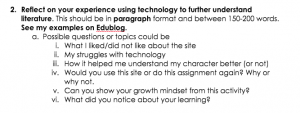
Reflection questions for characterization assignment
I noticed that the students who were not challenged by this activity, because they are so tech intuitive, were eager to use the site again but their reflection was more about a description of the site than their thinking. In hindsight, and after reading Tom Bourner’s article, Assessing reflective thinking, my questions were surface level and did not lead to deep questioning or thinking. You will see how I improved the reflection process in the project below.
Collaboration when not in the classroom is a challenge, but when the students met for the bi-weekly discussion groups, they used platforms such as padlet to share their assignments and discuss their findings. They also met on Microsoft Teams for video conferencing.
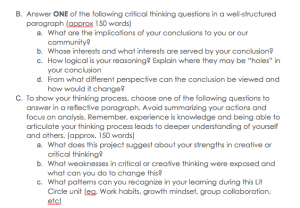
New critical thinking and reflection questions
For their final project, I wanted to build on what they had already done so asked to answer their novel’s inquiry question through a mind map, an infographic, a blog post, or an educational video. They are then asked to reflect critically on their conclusion. I am curious about these paragraphs. Constructive learning is only meaningful if “the learners articulate what they have accomplished and reflect on their activity and observations-to learn the lessons that their activity has to teach. (Howland, et al., 2012, pg. 3) For someone like myself, I know I struggle articulating my metacognitive process so when Bourne states, “…one reason why some people are poor at reflective learning is that they have a limited repertoire of searching, reflective questions” (2003, p. 271) I knew I had the prepare thoughtful, searching questions for my students to use. I used some of his critical questions suggestions to guide students through their examination of their conclusion, and I used his reflective thinking suggestions to guide them through their reflection. The students are finishing this project next week, so for the sake of this blog, I cannot share the results, but I am hoping they will be more insightful on their learning.
Conclusion
Integrating technology in a meaningful way means students learn from technology and with technology. I am hoping that when I receive my students reflections after completing the literature circle project, I will read a sense of deeper thinking as the student recognize how their school computers are a part of the learning process, not just a tool for word processing and research. And I am looking forward to seeing how much they engage in the digital story telling assignments. Just like the students, I am on this journey of discovery too. I think we can learn alongside each other in powerful, authentic, meaningful way.
Works Cited
Bourner, Tom. (2003). Assessing reflective learning. Education Training, 45(5), 267-72.
Howland, J., Jonassen, D., & Marra, R. (2012). Meaningful learning with technology, 4th Edition. Pearson.
Petrich, M., Wilkinson, K., & Brevan, B. (2013). It looks like fun, but are they learning? In, Honey, M., & Kanter, D. (Eds). Design, make, play: Growing the next generation of STEM innovators. New York, NY: Routledge.
Resnick, M., (2016) Let’s teach kids to code
Tishman, S., Jay, E., & Perkins, D. N. (1993). Teaching thinking dispositions: From transmission to enculturation. Theory into practice, 32(3), pp. 147–153.

